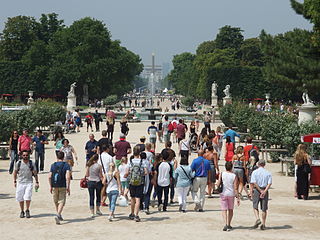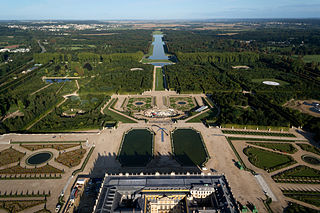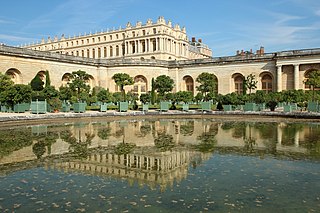
A garden is a planned space, usually outdoors, set aside for the cultivation, display, and enjoyment of plants and other forms of nature. The single feature identifying even the wildest wild garden is control. The garden can incorporate both natural and artificial materials.

The Tuileries Garden is a public garden located between the Louvre and the Place de la Concorde in the 1st arrondissement of Paris, France. Created by Catherine de' Medici as the garden of the Tuileries Palace in 1564, it was eventually opened to the public in 1667 and became a public park after the French Revolution. Since the 19th century, it has been a place where Parisians celebrate, meet, stroll and relax.

A parterre is a part of a formal garden constructed on a level substrate, consisting of symmetrical patterns, made up by plant beds, low hedges or coloured gravels, which are separated and connected by paths. Typically it was the part of the garden nearest the house, perhaps after a terrace. The view of it from inside the house, especially from the upper floors, was a major consideration in its design. The word "parterre" was and is used both for the whole part of the garden containing parterres and for each individual section between the "alleys".
Garden design is the art and process of designing and creating plans for layout and planting of gardens and landscapes. Garden design may be done by the garden owner themselves, or by professionals of varying levels of experience and expertise. Most professional garden designers have some training in horticulture and the principles of design. Some are also landscape architects, a more formal level of training that usually requires an advanced degree and often a state license. Amateur gardeners may also attain a high level of experience from extensive hours working in their own gardens, through casual study, serious study in Master gardener programs, or by joining gardening clubs.

The family of Dezallier d'Argenville produced two writers and connoisseurs, father and son, in the course of the 18th century. The father, Antoine-Joseph Dezallier d'Argenville (1680–1765) is now best known for writing the fullest French treatise on the French formal garden style of his lifetime, as well as books on natural history, and as a significant collector of old master prints.
André Mollet was a French garden designer, the son of Claude Mollet—gardener to three French kings—and the grandson of Jacques Mollet, gardener at the château d'Anet, where Italian formal gardening was introduced to France.

Jacques Boyceau, sieur de la Barauderie was a French garden designer, the superintendent of royal gardens under Louis XIII, whose posthumously produced Traité du iardinage selon les raisons de la nature et de l'art. Ensemble divers desseins de parterres, pelouzes, bosquets et autres ornements was published in 1638. Its sixty engravings after Boyceau's designs make it one of the milestones in tracing the history of the Garden à la française. His nephew Jacques de Menours, who produced the volume, included an engraved frontispiece with the portrait of Boyceau.

Claude Mollet, premier jardinier du Roy — first gardener to three French kings, Henri IV, Louis XIII and the young Louis XIV — was a member of the Mollet dynasty of French garden designers in the seventeenth century. His father was Jacques Mollet, gardener at the château d'Anet, where Italian formal gardening was introduced to France and where Claude apprenticed, and his son was André Mollet, who took the French style to Holland, Sweden and England.

Claude Desgots was a French architect and landscape architect, who designed French formal gardens in France and England. He worked with and was strongly influenced by André Le Nôtre, the designer of the gardens at Vaux-le-Vicomte and Versailles that set the pattern for grand gardening in France up to the Revolution. In spite of increasing competition from the informal English landscape style, the French tradition was kept vital through apprenticeship connections in the generation following Le Nôtre's death in 1700, and a principal representative in this tradition was Claude Desgots, "a worthy heir and a great talent in gardening", remarked the master teacher of architecture Jacques-François Blondel.

The Château de Saint-Germain-en-Laye is a former royal palace in the commune of Saint-Germain-en-Laye, in the département of Yvelines, about 19 km west of Paris, France. Today, it houses the musée d'Archéologie nationale.

André Le Nôtre, originally rendered as André Le Nostre, was a French landscape architect and the principal gardener of King Louis XIV of France. He was the landscape architect who designed the gardens of the Palace of Versailles; his work represents the height of the French formal garden style, or jardin à la française.

The Gardens of Versailles occupy part of what was once the Domaine royal de Versailles, the royal demesne of the château of Versailles. Situated to the west of the palace, the gardens cover some 800 hectares of land, much of which is landscaped in the classic French formal garden style perfected here by André Le Nôtre. Beyond the surrounding belt of woodland, the gardens are bordered by the urban areas of Versailles to the east and Le Chesnay to the north-east, by the National Arboretum de Chèvreloup to the north, the Versailles plain to the west, and by the Satory Forest to the south.

Pleaching or plashing is a technique of interweaving living and dead branches through a hedge creating a fence, hedge or lattices. Trees are planted in lines, and the branches are woven together to strengthen and fill any weak spots until the hedge thickens. Branches in close contact may grow together, due to a natural phenomenon called inosculation, a natural graft. Pleach also means weaving of thin, whippy stems of trees to form a basketry effect.

The French formal garden, also called the jardin à la française, is a style of garden based on symmetry and the principle of imposing order on nature. Its epitome is generally considered to be the Gardens of Versailles designed during the 17th century by the landscape architect André Le Nôtre for Louis XIV and widely copied by other European courts.

The Versailles Orangerie was built by Jules Hardouin-Mansart between 1684 and 1686, before work on the Château de Versailles had even begun. The Orangerie, which replaced Louis Le Vau's earlier design from 1663, is an example of many such prestigious extensions of grand gardens in Europe designed both to shelter tender plants and impress visitors. With the addition of the Orangerie, the gardens, no longer reserved solely for use by Louis XIV, had the added use of a theatrical setting that could be used to entertain guests at court.

The Baroque garden was a style of garden based upon symmetry and the principle of imposing order on nature. The style originated in the late-16th century in Italy, in the gardens of the Vatican and the Villa Borghese gardens in Rome and in the gardens of the Villa d'Este in Tivoli, and then spread to France, where it became known as the jardin à la française or French formal garden. The grandest example is found in the Gardens of Versailles designed during the 17th century by the landscape architect André Le Nôtre for Louis XIV. In the 18th century, in imitation of Versailles, very ornate Baroque gardens were built in other parts of Europe, including Germany, Austria, Spain, and in Saint-Petersburg, Russia. In the mid-18th century the style was replaced by the less geometric and more natural English landscape garden.

Writing about gardens takes a variety of literary forms, ranging from instructional manuals on horticulture and garden design, to essays on gardening, to novels. Garden writing has been published in English since at least the 16th century.

In the Western history of gardening, from the 16th to early 19th centuries, a wilderness was a highly artificial and formalized type of woodland, forming a section of a large garden. Though examples varied greatly, a typical English style was a number of geometrically-arranged compartments closed round by hedges, each compartment planted inside with relatively small trees. Between the compartments there were wide walkways or "alleys", usually of grass, sometimes of gravel. The wilderness provided shade in hot weather, and relative privacy. Though often said by garden writers at the time to be intended for meditation and reading, the wilderness was much used for walking, and often flirtation. There were few if any flowers, but there might be statues, and some seating, especially in garden rooms or salle vertes, clearings left empty. Some had other features, such as a garden maze.




















